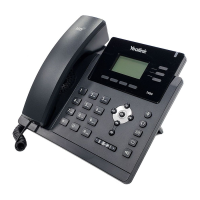Network Configurations
63
static.network.l2tp_server.username = vpnuser
static.network.l2tp_server.password = 0123456
2.
After provisioning, connect the phone to the VPN environment.
Exporting the OpenVPN Configuration File from the Phone
You can export the OpenVPN configuration file via web user interface.
Procedure
1. From the web user interface, click Network > Advanced > VPN.
2.
Turn on VPN feature.
3. In the Export VPN Configuration File field, click Export to open the file download window, and then save the
file to your local system.
Importing the OpenVPN Configuration File to Phone
You can import the OpenVPN configuration file from local to the phones via the web user interface. The changes in
the configuration file will take effect after the file is imported.
Procedure
1. From the web user interface, click Network > Advanced > VPN.
2.
Turn on VPN feature.
3. In the Import VPN Configuration File field, click Browse to locate a OpenVPN configuration file in your local sys-
tem.
4. Click Upload to import the configuration file.
Quality of Service (QoS)
VoIP is extremely bandwidth and delay-sensitive. QoS is a major issue in VoIP implementations, regarding how to
guarantee that packet traffic is not delayed or dropped due to interference from other lower priority traffic. VoIP can
guarantee high-quality QoS only if the voice and the SIP packets are given priority over other kinds of network
traffic. The phones support the DiffServ model of QoS.
Voice QoS
In order to make VoIP transmissions intelligible to receivers, voice packets should not be dropped, excessively
delayed, or made to suffer varying delay. DiffServ model can guarantee high-quality voice transmission when the
voice packets are configured to a higher DSCP value.
SIP QoS
The SIP protocol is used for creating, modifying, and terminating two-party or multi-party sessions. To ensure good
voice quality, SIP packets emanated from the phones should be configured with a high transmission priority.
DSCPs for voice and SIP packets can be specified respectively.
Note: For voice and SIP packets, the phone obtains DSCP info from the network policy if LLDP feature is enabled, which
takes precedence over manual settings. For more information on LLDP, refer to LLDP Configuration.
Topic
Voice and SIP QoS Configuration
Voice and SIP QoS Configuration
The following table lists the parameters you can use to configure voice QoS and SIP QoS.
Parameter
static.network.qos.audiotos
[1]
<y0000000000xx>.cfg
Description
It configures the DSCP (Differentiated Services Code Point) for voice packets.

